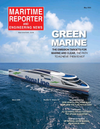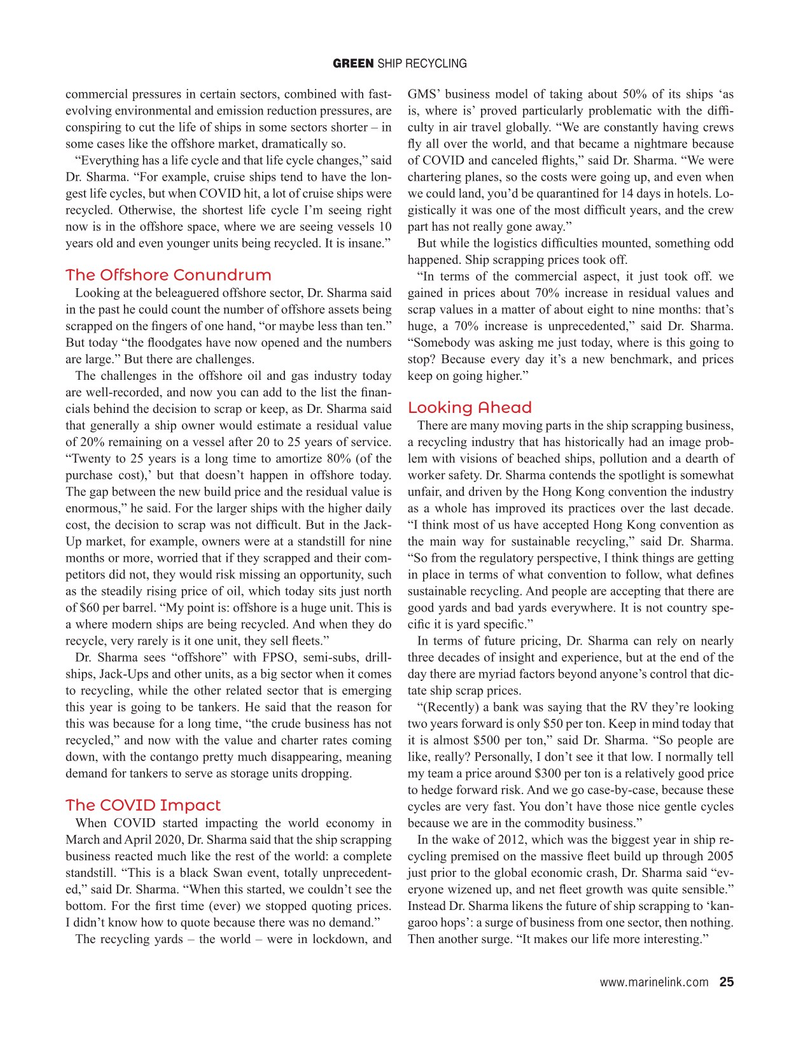
Page 25: of Maritime Reporter Magazine (May 2021)
Green Ship Technologies
Read this page in Pdf, Flash or Html5 edition of May 2021 Maritime Reporter Magazine
GREEN SHIP RECYCLING commercial pressures in certain sectors, combined with fast- GMS’ business model of taking about 50% of its ships ‘as evolving environmental and emission reduction pressures, are is, where is’ proved particularly problematic with the dif? - conspiring to cut the life of ships in some sectors shorter – in culty in air travel globally. “We are constantly having crews some cases like the offshore market, dramatically so. ? y all over the world, and that became a nightmare because “Everything has a life cycle and that life cycle changes,” said of COVID and canceled ? ights,” said Dr. Sharma. “We were
Dr. Sharma. “For example, cruise ships tend to have the lon- chartering planes, so the costs were going up, and even when gest life cycles, but when COVID hit, a lot of cruise ships were we could land, you’d be quarantined for 14 days in hotels. Lo- recycled. Otherwise, the shortest life cycle I’m seeing right gistically it was one of the most dif? cult years, and the crew now is in the offshore space, where we are seeing vessels 10 part has not really gone away.” years old and even younger units being recycled. It is insane.” But while the logistics dif? culties mounted, something odd happened. Ship scrapping prices took off.
The Offshore Conundrum “In terms of the commercial aspect, it just took off. we
Looking at the beleaguered offshore sector, Dr. Sharma said gained in prices about 70% increase in residual values and in the past he could count the number of offshore assets being scrap values in a matter of about eight to nine months: that’s scrapped on the ? ngers of one hand, “or maybe less than ten.” huge, a 70% increase is unprecedented,” said Dr. Sharma.
But today “the ? oodgates have now opened and the numbers “Somebody was asking me just today, where is this going to are large.” But there are challenges. stop? Because every day it’s a new benchmark, and prices
The challenges in the offshore oil and gas industry today keep on going higher.” are well-recorded, and now you can add to the list the ? nan- cials behind the decision to scrap or keep, as Dr. Sharma said Looking Ahead that generally a ship owner would estimate a residual value There are many moving parts in the ship scrapping business, of 20% remaining on a vessel after 20 to 25 years of service. a recycling industry that has historically had an image prob- “Twenty to 25 years is a long time to amortize 80% (of the lem with visions of beached ships, pollution and a dearth of purchase cost),’ but that doesn’t happen in offshore today. worker safety. Dr. Sharma contends the spotlight is somewhat
The gap between the new build price and the residual value is unfair, and driven by the Hong Kong convention the industry enormous,” he said. For the larger ships with the higher daily as a whole has improved its practices over the last decade. cost, the decision to scrap was not dif? cult. But in the Jack- “I think most of us have accepted Hong Kong convention as
Up market, for example, owners were at a standstill for nine the main way for sustainable recycling,” said Dr. Sharma. months or more, worried that if they scrapped and their com- “So from the regulatory perspective, I think things are getting petitors did not, they would risk missing an opportunity, such in place in terms of what convention to follow, what de? nes as the steadily rising price of oil, which today sits just north sustainable recycling. And people are accepting that there are of $60 per barrel. “My point is: offshore is a huge unit. This is good yards and bad yards everywhere. It is not country spe- a where modern ships are being recycled. And when they do ci? c it is yard speci? c.” recycle, very rarely is it one unit, they sell ? eets.” In terms of future pricing, Dr. Sharma can rely on nearly
Dr. Sharma sees “offshore” with FPSO, semi-subs, drill- three decades of insight and experience, but at the end of the ships, Jack-Ups and other units, as a big sector when it comes day there are myriad factors beyond anyone’s control that dic- to recycling, while the other related sector that is emerging tate ship scrap prices. this year is going to be tankers. He said that the reason for “(Recently) a bank was saying that the RV they’re looking this was because for a long time, “the crude business has not two years forward is only $50 per ton. Keep in mind today that recycled,” and now with the value and charter rates coming it is almost $500 per ton,” said Dr. Sharma. “So people are down, with the contango pretty much disappearing, meaning like, really? Personally, I don’t see it that low. I normally tell demand for tankers to serve as storage units dropping. my team a price around $300 per ton is a relatively good price to hedge forward risk. And we go case-by-case, because these cycles are very fast. You don’t have those nice gentle cycles
The COVID Impact
When COVID started impacting the world economy in because we are in the commodity business.”
March and April 2020, Dr. Sharma said that the ship scrapping In the wake of 2012, which was the biggest year in ship re- business reacted much like the rest of the world: a complete cycling premised on the massive ? eet build up through 2005 standstill. “This is a black Swan event, totally unprecedent- just prior to the global economic crash, Dr. Sharma said “ev- ed,” said Dr. Sharma. “When this started, we couldn’t see the eryone wizened up, and net ? eet growth was quite sensible.” bottom. For the ? rst time (ever) we stopped quoting prices. Instead Dr. Sharma likens the future of ship scrapping to ‘kan-
I didn’t know how to quote because there was no demand.” garoo hops’: a surge of business from one sector, then nothing.
The recycling yards – the world – were in lockdown, and Then another surge. “It makes our life more interesting.” www.marinelink.com 25
MR #5 (18-33).indd 25 5/6/2021 5:25:40 PM

 24
24

 26
26
